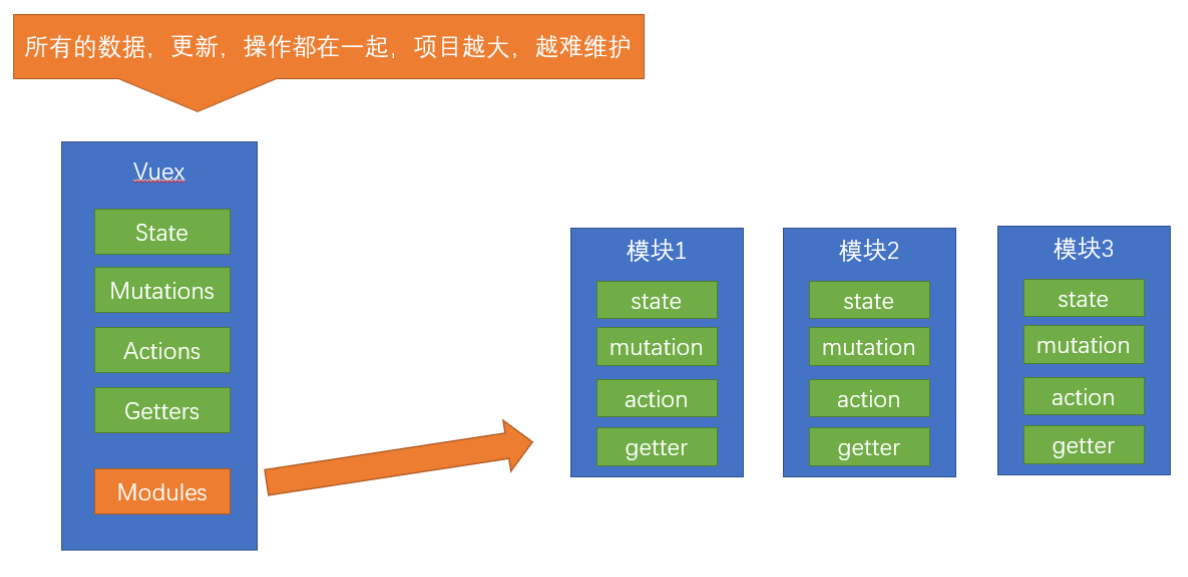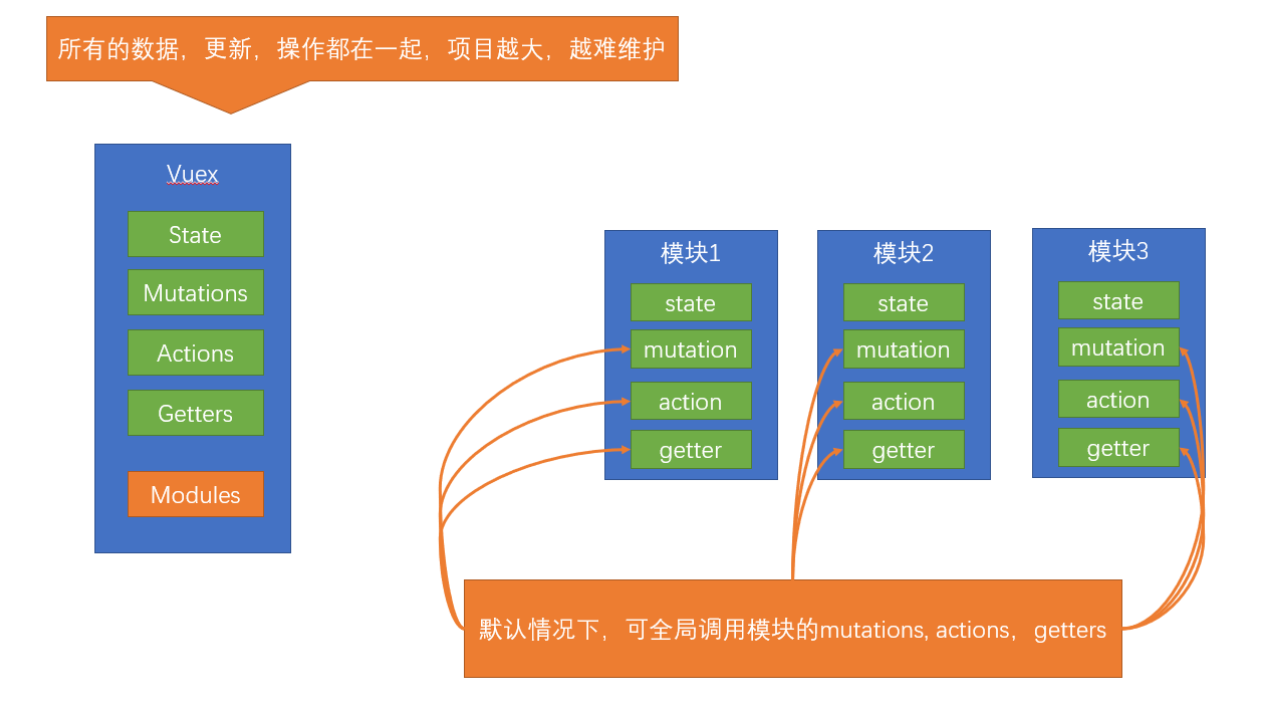VueX
vuex基本概念
vuex是vue的状态管理工具,状态即数据。 状态管理就是集中管理vue中 通用的 一些数据
注意(官方原文):
- 不是所有的场景都适用于vuex,只有在必要的时候才使用vuex
- 使用了vuex之后,会附加更多的框架中的概念进来,增加了项目的复杂度 (数据的操作更便捷,数据的流动更清晰)
Vuex就像《近视眼镜》, 你自然会知道什么时候需要用它~
vuex的优点: 方便的解决多组件的共享状态
vuex的作用是解决《多组件状态共享》的问题。
它是独立于组件而单独存在的,所有的组件都可以把它当作 一座桥梁 来进行通讯。
特点:
- 响应式: 只要仓库一变化,其他所有地方都更新 (太爽了!!!)
- 操作更简洁
代码量非常少, 但是需要熟悉

什么数据适合存到vuex中
一般情况下,只有 多个组件均需要共享的数据 ,才有必要存储在vuex中,
对于某个组件中的私有数据,依旧存储在组件自身的data中。
例如:
- 对于所有组件而言,当前登陆的 用户信息 是需要在全体组件之间共享的,则它可以放在vuex中
- 对于文章详情页组件来说,当前的用户浏览的文章列表数据则应该属于这个组件的私有数据,应该要放在这个组件data中。
vuex 的使用 - 创建仓库
1 安装 vuex, 与vue-router类似,vuex是一个独立存在的插件,如果脚手架初始化没有选 vuex,就需要额外安装。
npm i [email protected]
2 新建 store/index.js 专门存放 vuex
为了维护项目目录的整洁,在src目录下新建一个store目录其下放置一个index.js文件。 (和 router/index.js 类似)
3 创建仓库 store/index.js
// 导入 vue
import Vue from 'vue'
// 导入 vuex
import Vuex from 'vuex'
// vuex也是vue的插件, 需要use一下, 进行插件的安装初始化
Vue.use(Vuex)
// 创建仓库 store
const store = new Vuex.Store()
// 导出仓库
export default store
4 在 main.js 中导入挂载到 Vue 实例上
import Vue from 'vue'
import App from './App.vue'
import store from './store'
Vue.config.productionTip = false
new Vue({
render: h => h(App),
store
}).$mount('#app')
此刻起, 就成功创建了一个 空仓库!!
核心概念 - state 状态
State提供唯一的公共数据源,所有共享的数据都要统一放到Store中的State中存储。
打开项目中的store.js文件,在state对象中可以添加我们要共享的数据。
// 创建仓库 store
const store = new Vuex.Store({
// state 状态, 即数据, 类似于vue组件中的data,
// 区别在于 data 是组件自己的数据, 而 state 中的数据整个vue项目的组件都能访问到
state: {
count: 101
}
})
问题: 如何在组件中获取count?
- 插值表达式 =》
{{ $store.state.count }} - mapState 映射计算属性 =》
{{ count }}
1. 原始形式- 插值表达式
App.vue
组件中可以使用 this.$store 获取到vuex中的store对象实例,可通过state属性属性获取count, 如下
<h1>state的数据 - {{ $store.state.count }}</h1>
计算属性 - 将state属性定义在计算属性中 https://vuex.vuejs.org/zh/guide/state.html
// 把state中数据,定义在组件内的计算属性中
computed: {
count () {
return this.$store.state.count
}
}
<h1>state的数据 - {{ count }}</h1>
但是每次, 都这样一个个的提供计算属性, 太麻烦了, 所以我们需要辅助函数 mapState 帮我们简化语法
2. 辅助函数 - mapState
mapState是辅助函数,帮助我们把store中的数据映射到 组件的计算属性中, 它属于一种方便的用法
用法 :
第一步:导入mapState (mapState是vuex中的一个函数)
import { mapState } from 'vuex'
第二步:采用数组形式引入state属性
mapState(['count'])
上面代码的最终得到的是 类似于
count () {
return this.$store.state.count
}
第三步:利用展开运算符将导出的状态映射给计算属性
computed: {
...mapState(['count'])
}
<div> state的数据:{{ count }}</div>
核心概念 - mutations
基本使用
通过 strict: true 可以开启严格模式
state数据的修改只能通过mutations,并且mutations必须是同步的
定义mutations
const store = new Vuex.Store({
state: {
count: 0
},
// 定义mutations
mutations: {
}
})
格式说明
mutations是一个对象,对象中存放修改state的方法
mutations: {
// 方法里参数 第一个参数是当前store的state属性
// payload 载荷 运输参数 调用mutaiions的时候 可以传递参数 传递载荷
addCount (state) {
state.count += 1
}
},
组件中提交 mutations
this.$store.commit('addCount')
解决问题: 两个子组件, 添加操作 add, addN 实现
带参数的 mutation
需求: 父组件也希望能改到数据
提交 mutation 是可以传递参数的 this.$store.commit('xxx', 参数)
1 提供mutation函数
mutations: {
...
inputCount (state, count) {
state.count = count
}
},
2 注册事件
<input type="text" :value="count" @input="handleInput">
3 提交mutation
handleInput (e) {
this.$store.commit('inputCount', +e.target.value)
}
小tips: 提交的参数只能是一个, 如果有多个参数要传, 可以传递一个对象
this.$store.commit('inputCount', {
count: e.target.value
})
解决问题: addN 的实现
辅助函数 - mapMutations
mapMutations和mapState很像,它把位于mutations中的方法提取了出来,我们可以将它导入
import { mapMutations } from 'vuex'
methods: {
...mapMutations(['addCount'])
}
上面代码的含义是将mutations的方法导入了methods中,等价于
methods: {
// commit(方法名, 载荷参数)
addCount () {
this.$store.commit('addCount')
}
}
此时,就可以直接通过this.addCount调用了
<button @click="addCount">值+1</button>
但是请注意: Vuex中mutations中要求不能写异步代码,如果有异步的ajax请求,应该放置在actions中
核心概念-actions
state是存放数据的,mutations是同步更新数据 (便于监测数据的变化, 更新视图等, 方便于调试工具查看变化), actions则负责进行异步操作
需求: 一秒钟之后, 要给一个数 去修改state

定义actions
actions: {
setAsyncCount (context, num) {
// 一秒后, 给一个数, 去修改 num
setTimeout(() => {
context.commit('inputCount', num)
}, 1000)
}
},
原始调用 - $store (支持传参)
setAsyncCount () {
this.$store.dispatch('setAsyncCount', 200)
}
辅助函数 -mapActions
actions也有辅助函数,可以将action导入到组件中
import { mapActions } from 'vuex'
methods: {
...mapActions(['setAsyncCount'])
}
直接通过 this.方法 就可以调用
<button @click="setAsyncCount(200)">+异步</button>
核心概念-getters
除了state之外,有时我们还需要从state中派生出一些状态,这些状态是依赖state的,此时会用到getters
例如,state中定义了list,为1-10的数组,
state: {
list: [1, 2, 3, 4, 5, 6, 7, 8, 9, 10]
}
组件中,需要显示所有大于5的数据,正常的方式,是需要list在组件中进行再一步的处理,但是getters可以帮助我们实现它
定义getters
getters: {
// getters函数的第一个参数是 state
// 必须要有返回值
filterList: state => state.list.filter(item => item > 5)
}
使用getters
原始方式 -$store
<div>{{ $store.getters.filterList }}</div>
辅助函数 - mapGetters
computed: {
...mapGetters(['filterList'])
}
<div>{{ filterList }}</div>
核心概念 - 模块 module (进阶拓展)
由于使用单一状态树,应用的所有状态会集中到一个比较大的对象。当应用变得非常复杂时,store 对象就有可能变得相当臃肿。
这句话的意思是,如果把所有的状态都放在state中,当项目变得越来越大的时候,Vuex会变得越来越难以维护
由此,又有了Vuex的模块化

定义一个模块 user
user中管理用户的信息状态 userInfo modules/user.js
const state = {
userInfo: {
name: 'zs',
age: 18
}
}
const mutations = {}
const actions = {}
const getters = {}
export default {
state,
mutations,
actions,
getters
}
使用模块中的数据, 可以直接通过模块名访问 $store.state.模块名.xxx => $store.state.user.title
也可以通过 mapState 映射
命名空间 namespaced
默认情况下,模块内部的 action、mutation 和 getter 是注册在全局命名空间的
这句话的意思是 刚才的 user模块 ,它的 action、mutation 和 getter 其实并没有区分,都可以直接通过全局的方式调用, 如下图所示:

但是,如果我们想保证内部模块的高封闭性,我们可以采用namespaced来进行设置
// aaa模块
export default {
namespaced:true, // 是否启用命名空间,实际开发基本都是true,它的默认值是false
state:{
// 自带了命名空间的
xxx:'zs'
// 访问:this.$store.state.模块名.xxx
},
// 下面的是默认不带命名空间的
mutations:{
setXxx(state,value){
state.xxx=value
}
// 调用mutations:this.$store.commit('模块名/方法名',实参)
},
actions:{
actionsXxx(store){
// store调用当前模块的mutations方法不需要模块名,访问任意当前模块的东西不需要模块名,只是外部调用需要
store.commit(“setXxx”,实参值)
}
// 调用actions:this.$store.dispatch('模块名/方法名',实参值)
},
getters:{
getXxx(state){
return "姓名:"+state.xxx
}
// 访问: this.$store.getters['模块名/getters方法名'] ,不用.语法是因为后面命名有/号,不符合命名规范
}
}
模块 map 用法
- mapState在computed中定义,mapGetters在computed中定义
- mapMutations在methods,mapActions在methods中定义
- 快捷批量使用vuex中的东西
- mapState
- 导入 import {mapState} from 'vuex'
computed:{
...mapState('模块名',['属性名'])
}
// 使用: this.属性名
- mapMutations
- 导入 import {mapMutations} from 'vuex'
methods:{
...mapMutations('模块名',['mutations方法名'])
}
// 调用: this.mutations方法名(实参)
- mapActions
import {mapActions} from 'vuex'
methods:{
...mapActions('模块名',['actions方法名'])
}
// 调用: this.actions方法名(实参)
- mapGetters
import {mapGetters} from 'vuex'
computed:{
...mapGetters('模块名',['getters方法名'])
}
// 访问:this.getters方法名
modules下的actions(了解)
// 某一模块下的使用
state:{
xxx:'zs'
},
actions:{
xxx(context){
content:{
// 这里面有什么呢?
state:访问当前模块的state数据
访问:state.属性名
rootState:访问根模块的state数据
访问根模块下的state: rootState.属性名
访问其它模块下的state: rootState.模块名.属性名
getters:用于访问当前模块的getters
访问:getters.getters方法名
rootGetters:用于访问根模块的getters,通过根模块能访问到所有模块的getters
访问根模块下的getters:rootGetters.根模块下的getters方法名
访问其它模块下的getters:rootGetters['模块名/其它模块的getters方法名']
commit:用于调用mutations方法
调用本模块的mutations方法:commit('本模块的mutations方法名',实参值)
调用其它模块的mutations方法:
commit('其它模块的模块名/其它模块的mutations方法名',实参,{root:true})
dispatch:用于调用actions方法
调用本模块的actions方法 :dispatch('本模块的actions方法名',实参值)
调用其它模块的actions方法
dispatch('其它模块的模块名/其它模块的actions方法名',实参,{root:true})
}
}
}
modules下的getters(了解)
getters:{
方法名(state,getters,rootState,rootGetters){
state:访问当前模块的state数据
访问:state.属性名
rootState:访问根模块的state数据
访问根模块下的state: rootState.属性名
访问其它模块下的state: rootState.模块名.属性名
getters:用于访问当前模块的getters
访问:getters.getters方法名
rootGetters:用于访问根模块的getters,通过根模块能访问到所有模块的getters
访问根模块下的getters:rootGetters.根模块下的getters方法名
访问其它模块下的getters:rootGetters['模块名/其它模块的getters方法名']
}
}
